Advancing Sustainable Materials: Synthesis and Analysis of Polyurethane Biocomposites from Hydrogenated Safflower Oil
Abstract
:Featured Application
Abstract
1. Introduction
2. Experimental Design and Methodology
2.1. Material Selection and Characteristics
2.2. The Preferred Method in Experimental Studies
2.3. Characterization Processes
3. Results and Discussion
3.1. Bulk Density Results
MDI + 1.04303 × 10−14 × CPP × HSO + 6.32478 × 10−15 × CPP × MDI + 7.25341 ×
10−15 × HSO × MDI + 0.024731 × (CPP)2 + 0.198331 × (HSO)2 + 0.005423 × (MDI)2
3.2. Shore A Hardness Results
× MDI − 0.183333 × CPP × HSO − 0.195833 × CPP × MDI + 0.029167 × HSO × MDI
3.3. Thermal Conductivity Results
0.010259 × MDI − 0.000044 × CPP × HSO − 0.000117 × CPP × MDI − 0.000025
×HSO × MDI − 0.000183 × (CPP)2 − 0.000175 × (HSO)2 − 0.000054 × (MDI)2
3.4. Dielectric Constant Results
MDI − 0.000556 × CPP × HSO − 0.000417 × CPP × MDI − 0.000417 × HSO ×
MDI + 0.004309 × (CPP)2 − 0.054091 × (HSO)2 + 0.00135 × (MDI)2
3.5. Tensile Strength
× MDI − 5.32743 × 10 − 16 × CPP × HSO − 1.90719 × 10 − 16 × CPP × MDI − 4.60682
× 10 − 16 × HSO × MDI + 0.003603 × (CPP)2 + 0.021203 × (HSO)2 + 0.000327 × (MDI)2
− 10.74444 × CPP × HSO − 0.10 × CPP × MDI − 0.10 × HSO × MDI + 7.83029 ×
(CPP)2 + 8.96629 × (HSO)2 + 0.140081 × (MDI)2
3.6. FT-IR Spectra Results
3.7. Microscopic Images
4. Discussion
Author Contributions
Funding
Data Availability Statement
Acknowledgments
Conflicts of Interest
References
- Sharma, B.K.; Adhvaryu, A.; Liu, Z.; Erhan, S.Z. Chemical modification of vegetable oils for lubricant applications. J. Am. Oil Chem. Soc. 2006, 83, 129–136. [Google Scholar] [CrossRef]
- Kamarudin, S.H.; Abdullah, L.C.; Aung, M.M.; Ratnam, C.T.; Jusoh @ Talib, E.R. A study of mechanical and morphological properties of PLA based biocomposites prepared with EJO vegetable oil based plasticiser and kenaf fibres. Mater. Res. Express 2018, 5, 85314. [Google Scholar] [CrossRef]
- Dinu, R.; Bejenari, I.; Volf, I.; Mija, A. Vegetable Oil-Based Resins Reinforced with Spruce Bark Powder and with Its Hydrochar Lignocellulosic Biomass. Appl. Sci. 2021, 11, 10649. [Google Scholar] [CrossRef]
- Veldsink, J.W.; Bouma, M.J.; Schöön, N.H.; Beenackers, A.A.C.M. Heterogeneous Hydrogenation of Vegetable Oils: A Literature Review. Catal. Rev. 1997, 39, 253–318. [Google Scholar] [CrossRef]
- Troncoso, F.D.; Tonetto, G.M. Highly stable platinum monolith catalyst for the hydrogenation of vegetable oil. Chem. Eng. Process.—Process Intensif. 2022, 170, 108669. [Google Scholar] [CrossRef]
- Wang, W.; Duong-Viet, C.; Truong-Phuoc, L.; Nhut, J.-M.; Vidal, L.; Pham-Huu, C. Activated carbon supported nickel catalyst for selective CO2 hydrogenation to synthetic methane under contactless induction heating. Catal. Today 2023, 418, 114073. [Google Scholar] [CrossRef]
- Toshtay, K. Liquid-phase hydrogenation of sunflower oil over platinum and nickel catalysts: Effects on activity and stereoselectivity. Results Eng. 2024, 21, 101970. [Google Scholar] [CrossRef]
- Fiore, A.M.; Romanazzi, G.; Leonelli, C.; Mastrorilli, P.; Dell’Anna, M.M. Partial Hydrogenation of Soybean and Waste Cooking Oil Biodiesel over Recyclable-Polymer-Supported Pd and Ni Nanoparticles. Catalysts 2022, 12, 506. [Google Scholar] [CrossRef]
- Gondim, F.F.; Rodrigues, J.G.; Aguiar, V.O.; de Fátima Vieira Marques, M.; Monteiro, S.N. Biocomposites of Cellulose Isolated from Coffee Processing By-Products and Incorporation in Poly(Butylene Adipate-Co-Terephthalate) (PBAT) Matrix: An Overview. Polymers 2024, 16, 314. [Google Scholar] [CrossRef]
- Karmakar, G.; Ghosh, P.; Kohli, K.; Sharma, B.K.; Erhan, S.Z. Chemicals from Vegetable Oils, Fatty Derivatives, and Plant Biomass. In Innovative Uses of Agricultural Products and Byproducts; ACS Symposium Series; American Chemical Society: Washington, DA, USA, 2020; Volume 1347, p. 1. ISBN 9780841237155. [Google Scholar] [CrossRef]
- Chieng, B.W.; Chieng, B.W.; Ibrahim, N.A.; Ibrahim, N.A.; Loo, Y.Y. Bioplasitcizer Epoxidized Vegetable Oils–Based Poly(Lactic Acid) Blends and Nanocomposites. In Handbook of Composites from Renewable Materials; John Wiley & Sons: Hoboken, NJ, USA, 2017; pp. 205–231. ISBN 9781119441632. [Google Scholar] [CrossRef]
- Uppar, R.; Dinesha, P.; Kumar, S. A critical review on vegetable oil-based bio-lubricants: Preparation, characterization, and challenges. Environ. Dev. Sustain. 2023, 25, 9011–9046. [Google Scholar] [CrossRef]
- Estevez, R.; López-Tenllado, F.J.; Montes, V.; Romero, A.A.; Bautista, F.M.; Luna, D. Characterization of Several 2-Ethylhexyl Nitrates with Vegetable Oil (Castor or Sunflower Oil) Blends in Triple Blends with Diesel, Working as Advanced Biofuels in C.I. Diesel Engines. Appl. Sci. 2024, 14, 11968. [Google Scholar] [CrossRef]
- Nibin, M.; Varuvel, E.G.; JS, F.J.; Vikneswaran, M. Evaluation of wheat germ oil biofuel in diesel engine with hydrogen, bioethanol dual fuel and fuel ionization strategies. Int. J. Hydrogen Energy 2024, 59, 889–902. [Google Scholar] [CrossRef]
- Viar, N.; Requies, J.M.; Agirre, I.; Iriondo, A.; García-Sancho, C.; Arias, P.L. HMF hydrogenolysis over carbon-supported Ni–Cu catalysts to produce hydrogenated biofuels. Energy 2022, 255, 124437. [Google Scholar] [CrossRef]
- He, Y.; Liu, R.; Yellezuome, D.; Peng, W.; Tabatabaei, M. Upgrading of biomass-derived bio-oil via catalytic hydrogenation with Rh and Pd catalysts. Renew. Energy 2022, 184, 487–497. [Google Scholar] [CrossRef]
- Al-kahtani, M.S.M.; Zhu, H.; Ibrahim, Y.E.; Haruna, S.I.; Al-qahtani, S.S.M. Study on the Mechanical Properties of Polyurethane-Cement Mortar Containing Nanosilica: RSM and Machine Learning Approach. Appl. Sci. 2023, 13, 13348. [Google Scholar] [CrossRef]
- Aydoğmuş, E.; Arslanoğlu, H.; Dağ, M. Production of waste polyethylene terephthalate reinforced biocomposite with RSM design and evaluation of thermophysical properties by ANN. J. Build. Eng. 2021, 44, 103337. [Google Scholar] [CrossRef]
- Veza, I.; Spraggon, M.; Fattah, I.M.R.; Idris, M. Response surface methodology (RSM) for optimizing engine performance and emissions fueled with biofuel: Review of RSM for sustainability energy transition. Results Eng. 2023, 18, 101213. [Google Scholar] [CrossRef]
- Abioye, K.J.; Harun, N.Y.; Arshad, U.; Sufian, S.; Yusuf, M.; Jagaba, A.H.; Ighalo, J.O.; Al-Kahtani, A.A.; Kamyab, H.; Kumar, A.; et al. Response surface methodology and artificial neural network modelling of palm oil decanter cake and alum sludge co-gasification for syngas (CO+H2) production. Int. J. Hydrogen Energy 2024, 84, 200–214. [Google Scholar] [CrossRef]
- Saelee, M.; Sivamaruthi, B.S.; Tansrisook, C.; Duangsri, S.; Chaiyasut, K.; Kesika, P.; Peerajan, S.; Chaiyasut, C. Response Surface Methodological Approach for Optimizing Theobroma cacao L. Oil Extraction. Appl. Sci. 2022, 12, 5482. [Google Scholar] [CrossRef]
- Kim, I.; Ha, J.-H.; Jeong, Y. Optimization of Extraction Conditions for Antioxidant Activity of Acer tegmentosum Using Response Surface Methodology. Appl. Sci. 2021, 11, 1134. [Google Scholar] [CrossRef]
- Gabrovska, M.; Nikolova, D.; Radonjić, V.; Karashanova, D.; Baeva, A.; Parvanova-Mancheva, T.; Tzvetkov, P.; Petrova, E.; Zarkova, G.; Krstić, J. Structure Engineering of Ni/SiO2 Vegetable Oil Hydrogenation Catalyst via CeO2. Int. J. Mol. Sci. 2024, 25, 7585. [Google Scholar] [CrossRef]
- Spiekermann, M.L.; Seidensticker, T. Catalytic processes for the selective hydrogenation of fats and oils: Reevaluating a mature technology for feedstock diversification. Catal. Sci. Technol. 2024, 14, 4390–4419. [Google Scholar] [CrossRef]
- Karabulut, I.; Kayahan, M.; Yaprak, S. Determination of changes in some physical and chemical properties of soybean oil during hydrogenation. Food Chem. 2003, 81, 453–456. [Google Scholar] [CrossRef]
- Li, M.; Fu, J.; Xing, S.; Yang, L.; Zhang, X.; Lv, P.; Wang, Z.; Yuan, Z. A novel catalyst with variable active sites for the direct hydrogenation of waste oils into jet fuel. Appl. Catal. B Environ. 2020, 260, 118114. [Google Scholar] [CrossRef]
- Shin, H.-W.; Hwang, J.-H.; Kim, E.-A.; Hong, T.-W. Evaluation of Hydrogenation Kinetics and Life Cycle Assessment on Mg2NiHx–CaO Composites. Materials 2021, 14, 2848. [Google Scholar] [CrossRef]
- Patterson, H.B.W. Chapter 8—Hydrogenation Methods; List, G.R., King, J.W.B.T.-H., Second, E., Eds.; AOCS Press: Hoboken, NJ, USA, 2011; pp. 189–278. ISBN 978-1-893997-93-6. [Google Scholar] [CrossRef]
- Dağ, M.; Aydoğmuş, E.; Yalçin, Z.G.; Arslanoğlu, H. Diatomite reinforced modified safflower oil-based epoxy biocomposite production: Optimization with RSM and assessment of outcomes by ANN. Mater. Today Commun. 2023, 35, 106327. [Google Scholar] [CrossRef]
- Gu, R.; Sain, M. Biobased Polyurethanes. In Handbook of Green Materials; Materials and Energy; World Scientific: Singapore, 2013; Volume 5, pp. 77–87. ISBN 978-981-4566-45-2. [Google Scholar] [CrossRef]
- Brzeska, J.; Piotrowska-Kirschling, A. A Brief Introduction to the Polyurethanes According to the Principles of Green Chemistry. Processes 2021, 9, 1929. [Google Scholar] [CrossRef]
- Adedeji, J.A.; Tetteh, E.K.; Amo-Duodu, G.; Armah, E.K.; Rathilal, S.; Chetty, M. Central Composite Design Optimisation of Banana Peels/Magnetite for Anaerobic Biogas Production from Wastewater. Appl. Sci. 2022, 12, 12037. [Google Scholar] [CrossRef]
- ASTM D638-22; Standard Test Method for Tensile Properties of Plastics. ASTM International: West Conshohocken, PA, USA, 2022.
- ASTM D2240-15; Standard Test Method for Rubber Property—Durometer Hardness. ASTM International: West Conshohocken, PA, USA, 2015.
- ASTM D5334-14; Standard Test Method for Determination of Thermal Conductivity of Soil and Soft Rock by Thermal Needle Probe Procedure. ASTM International: West Conshohocken, PA, USA, 2014.
- ASTM D150-20; Standard Test Method for AC Loss Characteristics and Permittivity (Dielectric Constant) of Solid Electrical Insulation. ASTM International: West Conshohocken, PA, USA, 2020.
- Afzal, G.; Rasool, T. Green synthesis of graphene oxide from invasive plant species (Nymphaeaceae) for enhancing cement paste microstructure and compressive strength. Bioresour. Technol. Rep. 2024, 28, 102005. [Google Scholar] [CrossRef]
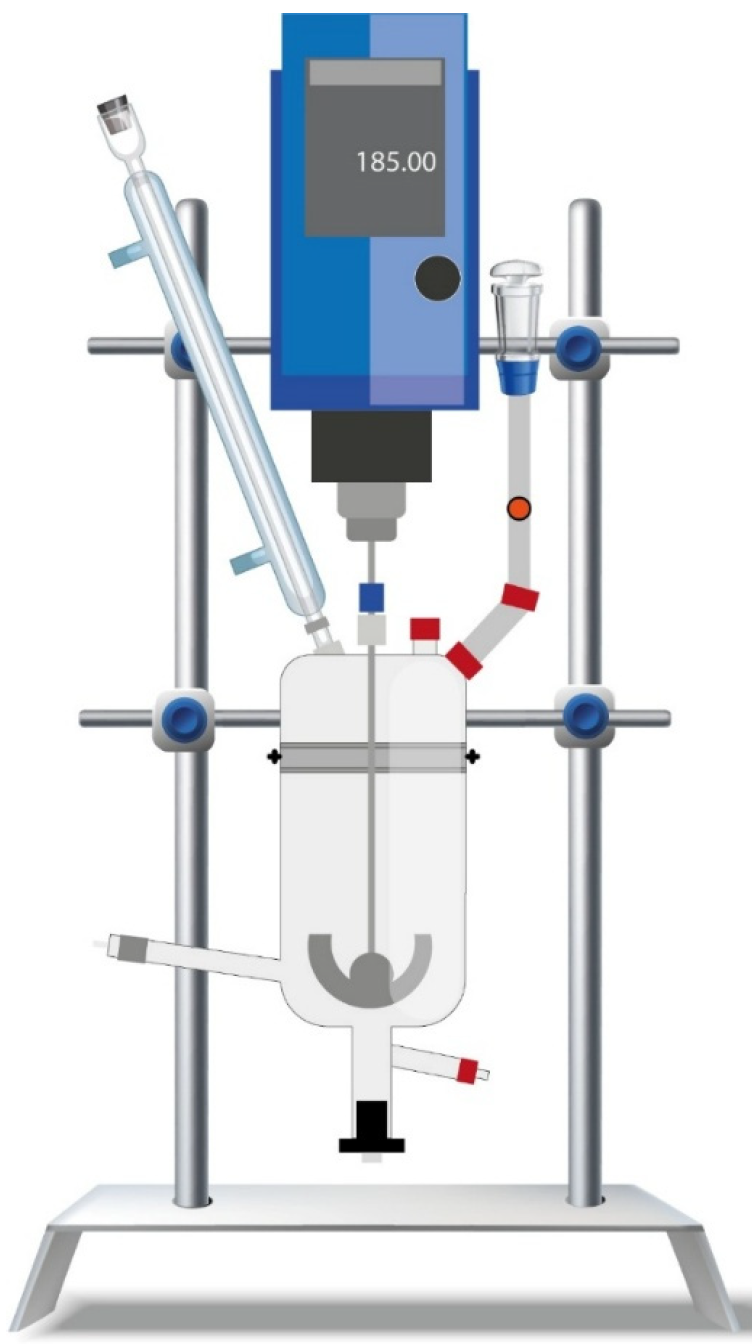
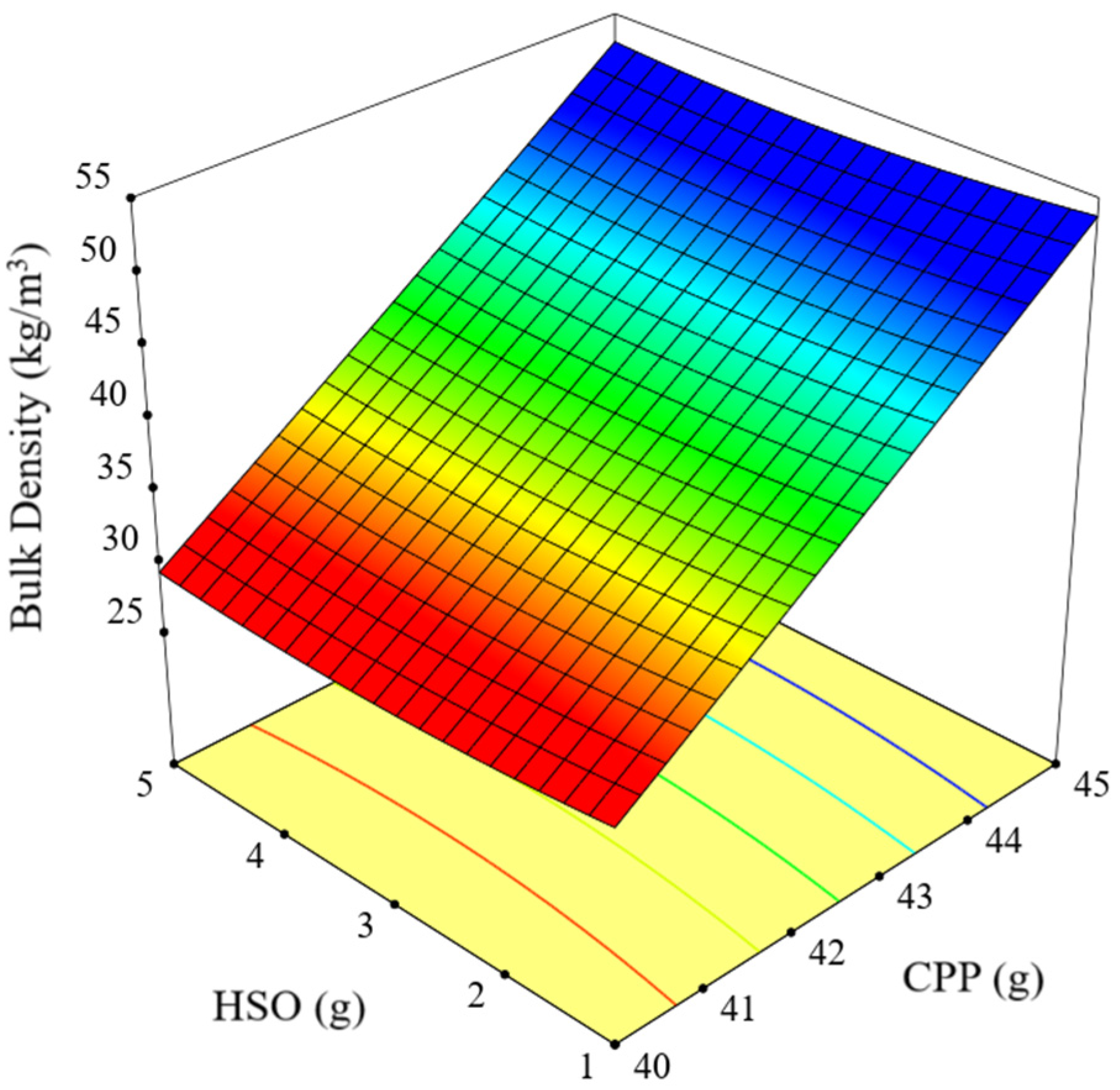
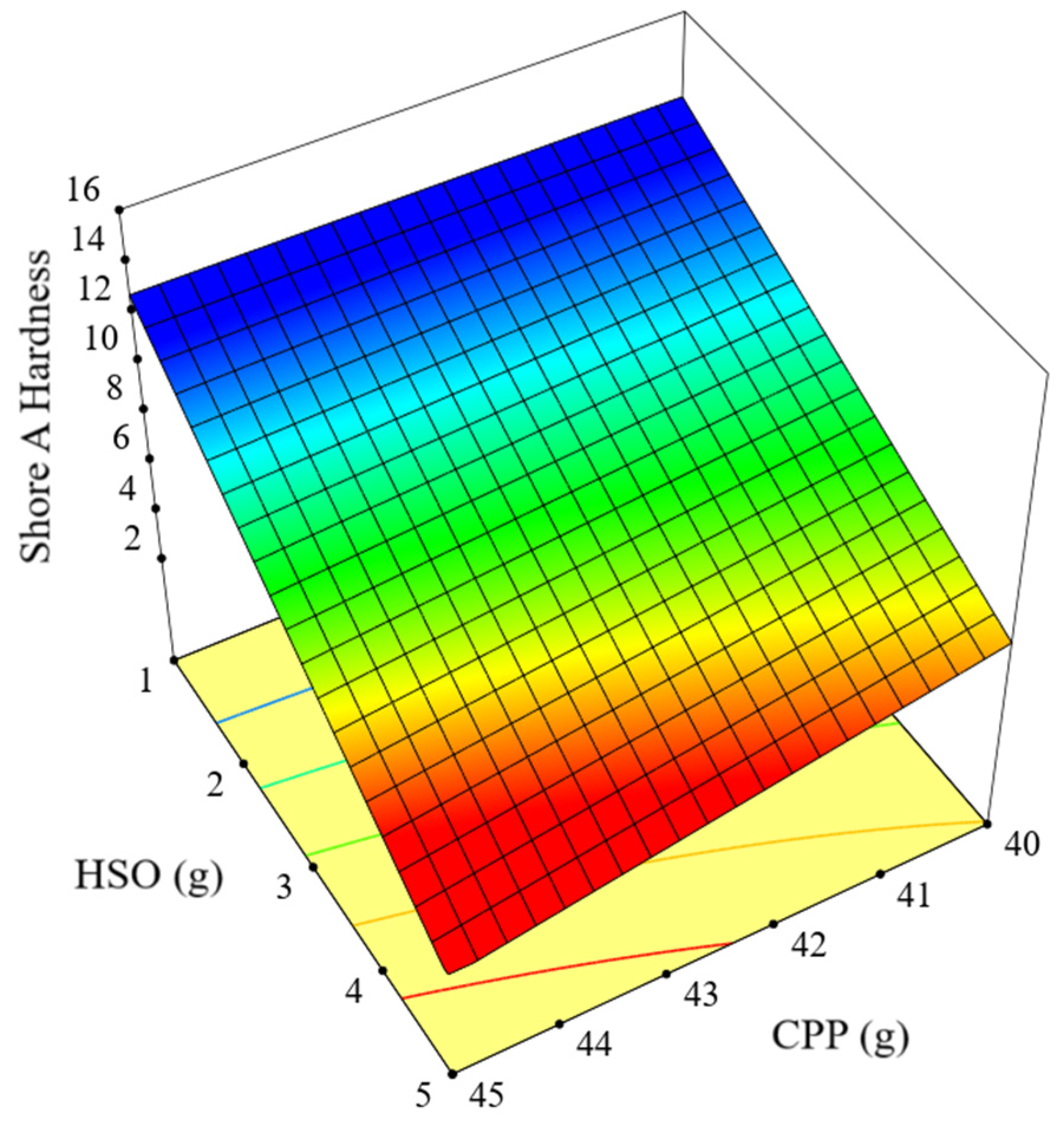

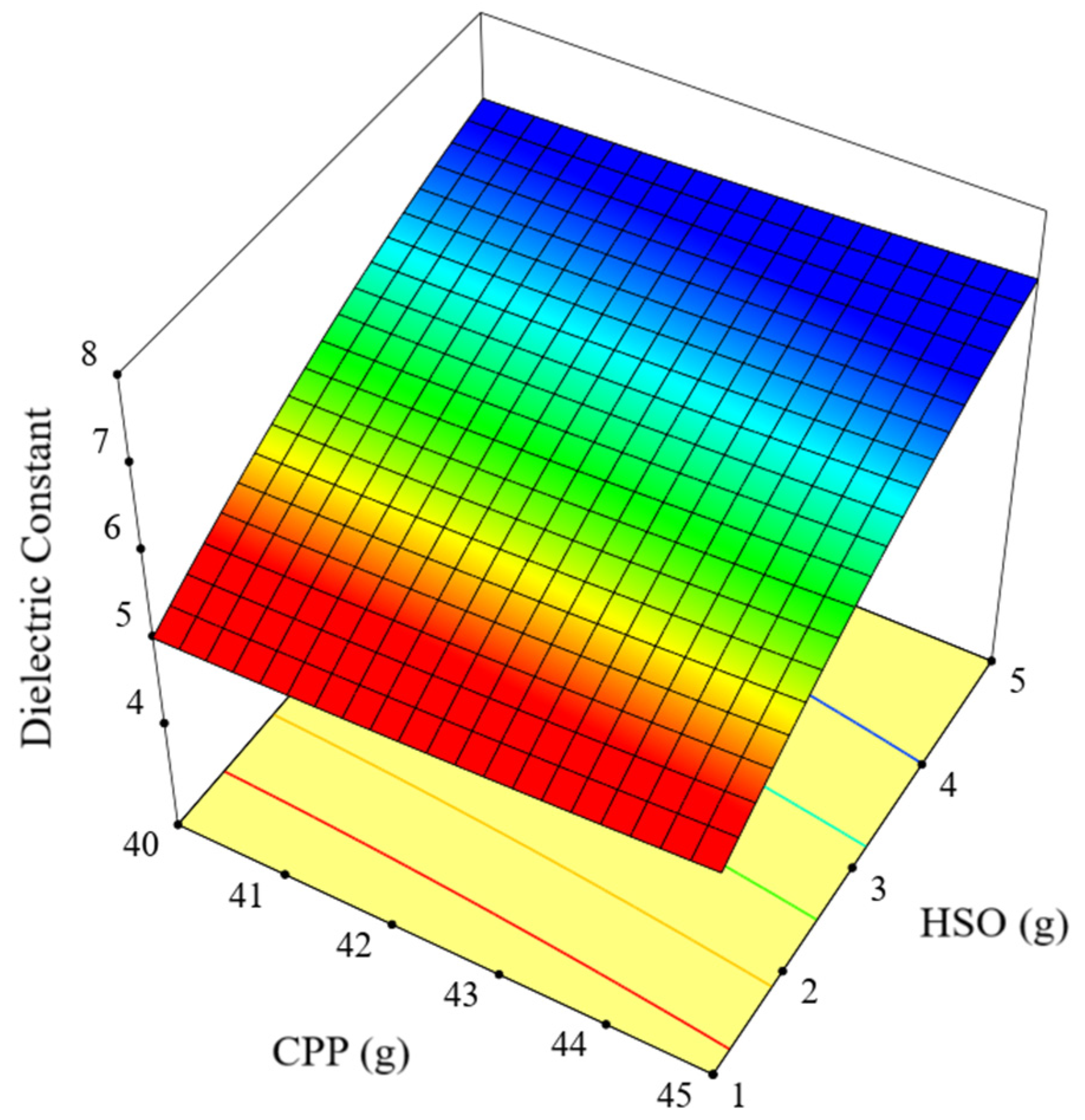
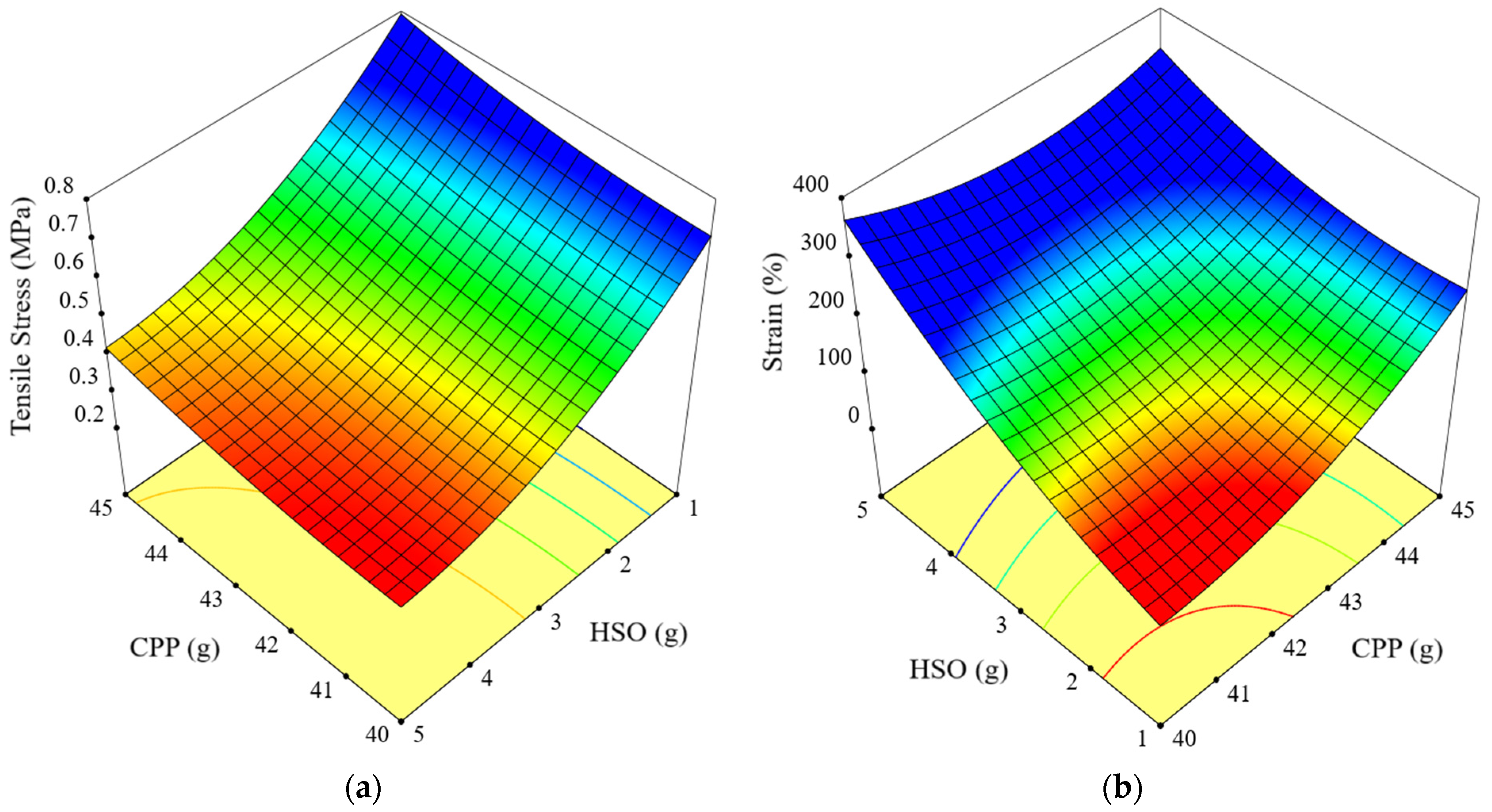


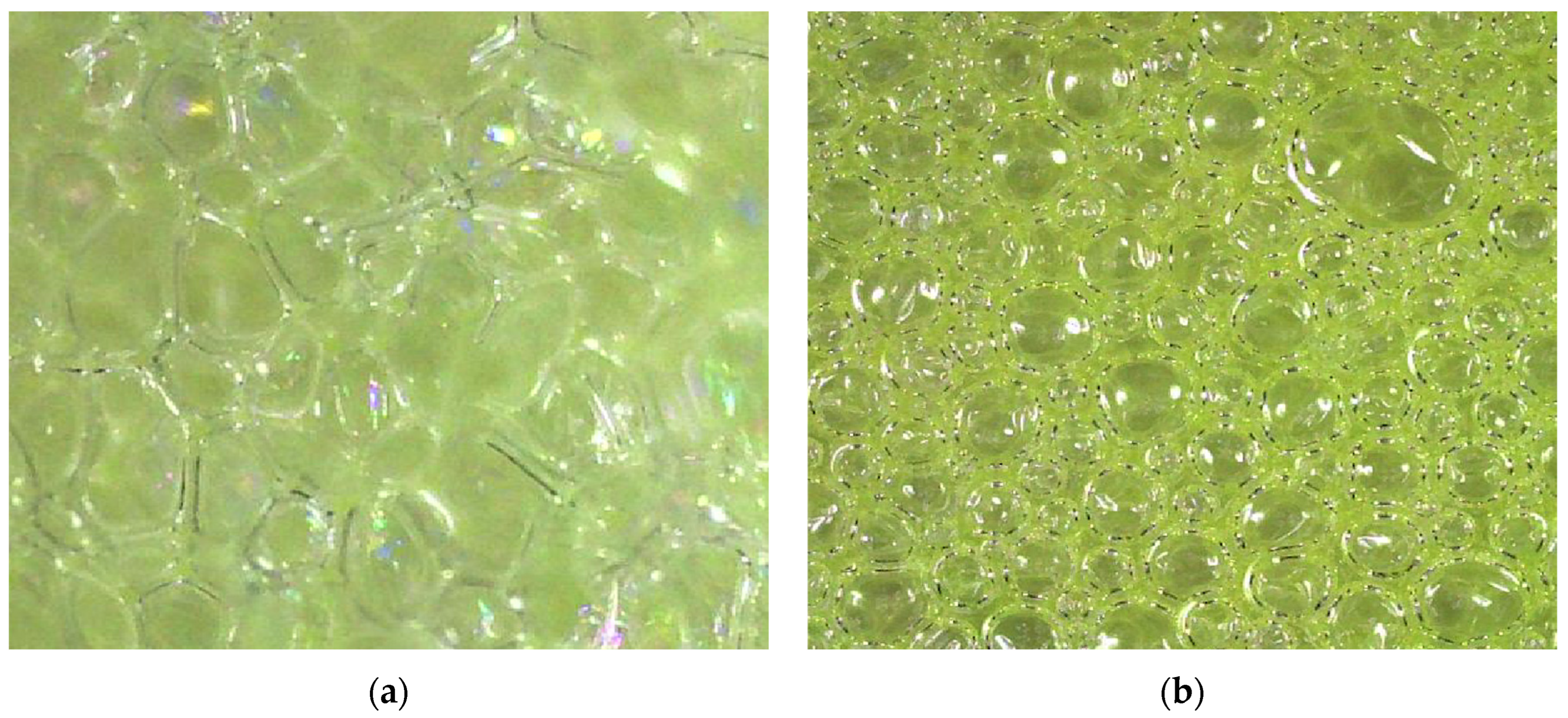
| Experiments | CPP (g) | HSO (g) | MDI (g) |
|---|---|---|---|
| 1 | 42.5 | 2.5 | 44 |
| 2 | 41 | 1 | 46 |
| 3 | 42.5 | 2.5 | 40 |
| 4 | 44 | 1 | 42 |
| 5 | 40 | 2.5 | 44 |
| 6 | 44 | 4 | 46 |
| 7 | 45 | 2.5 | 44 |
| 8 | 42.5 | 2.5 | 44 |
| 9 | 42.5 | 2.5 | 44 |
| 10 | 42.5 | 5 | 44 |
| 11 | 42.5 | 0 | 44 |
| 12 | 41 | 4 | 46 |
| 13 | 42.5 | 2.5 | 48 |
| 14 | 41 | 1 | 42 |
| 15 | 44 | 4 | 42 |
| 16 | 44 | 1 | 46 |
| 17 | 41 | 4 | 42 |
| Source | Sum of Squares | Mean Square | F-Value | p-Value |
|---|---|---|---|---|
| Model | 968.60 | 107.62 | 4324.86 | <0.0001 |
| A—CPP (g) | 681.33 | 681.33 | 27,379.65 | <0.0001 |
| B—HSO (g) | 4.72 | 4.72 | 189.73 | <0.0001 |
| C—MDI (g) | 280.23 | 280.23 | 11,261.06 | <0.0001 |
| AB | 0.0000 | 0.0000 | 0.0000 | 1.0000 |
| AC | 0.0000 | 0.0000 | 0.0000 | 1.0000 |
| BC | 0.0000 | 0.0000 | 0.0000 | 1.0000 |
| A2 | 0.0326 | 0.0326 | 1.31 | 0.2899 |
| B2 | 2.10 | 2.10 | 84.31 | <0.0001 |
| C2 | 0.0096 | 0.0096 | 0.3843 | 0.5549 |
| Residual | 0.1742 | 0.0249 | ||
| Lack of Fit | 0.1742 | 0.0348 | ||
| Pure Error | 0.0000 | 0.0000 | ||
| Cor Total | 968.78 |
| Source | Sum of Squares | Mean Square | F-Value | p-Value |
|---|---|---|---|---|
| Model | 172.22 | 28.70 | 281.92 | <0.0001 |
| A—CPP (g) | 2.12 | 2.12 | 20.87 | 0.0010 |
| B—HSO (g) | 159.28 | 159.28 | 1564.44 | <0.0001 |
| C—MDI (g) | 6.63 | 6.63 | 65.13 | <0.0001 |
| AB | 1.36 | 1.36 | 13.37 | 0.0044 |
| AC | 2.76 | 2.76 | 27.12 | 0.0004 |
| BC | 0.0613 | 0.0613 | 0.6016 | 0.4559 |
| Residual | 1.02 | 0.1018 | ||
| Lack of Fit | 1.02 | 0.1273 | ||
| Pure Error | 0.0000 | 0.0000 | ||
| Cor Total | 173.24 |
| Source | Sum of Squares | Mean Square | F-Value | p-Value |
|---|---|---|---|---|
| Model | 0.0000 | 4.126 × 10−6 | 269.61 | <0.0001 |
| A—CPP (g) | 3.895 × 10−6 | 3.895 × 10−6 | 254.54 | <0.0001 |
| B—HSO (g) | 0.0000 | 0.0000 | 878.53 | <0.0001 |
| C—MDI (g) | 0.0000 | 0.0000 | 1045.51 | <0.0001 |
| AB | 8.000 × 10−8 | 8.000 × 10−8 | 5.23 | 0.0561 |
| AC | 9.800 × 10−7 | 9.800 × 10−7 | 64.04 | <0.0001 |
| BC | 4.500 × 10−8 | 4.500 × 10−8 | 2.94 | 0.1301 |
| A2 | 1.784 × 10−6 | 1.784 × 10−6 | 116.56 | <0.0001 |
| B2 | 1.631 × 10−6 | 1.631 × 10−6 | 106.59 | <0.0001 |
| C2 | 9.427 × 10−7 | 9.427 × 10−7 | 61.60 | 0.0001 |
| Residual | 1.071 × 10−7 | 1.530 × 10−8 | ||
| Lack of Fit | 1.071 × 10−7 | 2.142 × 10−8 | ||
| Pure Error | 0.0000 | 0.0000 | ||
| Cor Total | 0.0000 |
| Source | Sum of Squares | Mean Square | F-Value | p-Value |
|---|---|---|---|---|
| Model | 9.69 | 1.08 | 148.70 | <0.0001 |
| A—CPP (g) | 0.0546 | 0.0546 | 7.53 | 0.0287 |
| B—HSO (g) | 9.44 | 9.44 | 1302.97 | <0.0001 |
| C—MDI (g) | 0.0003 | 0.0003 | 0.0423 | 0.8429 |
| AB | 0.0000 | 0.0000 | 0.0017 | 0.9680 |
| AC | 0.0000 | 0.0000 | 0.0017 | 0.9680 |
| BC | 0.0000 | 0.0000 | 0.0017 | 0.9680 |
| A2 | 0.0010 | 0.0010 | 0.1368 | 0.7225 |
| B2 | 0.1561 | 0.1561 | 21.55 | 0.0024 |
| C2 | 0.0006 | 0.0006 | 0.0819 | 0.7831 |
| Residual | 0.0507 | 0.0072 | ||
| Lack of Fit | 0.0507 | 0.0101 |
| Tensile Strength | Strain (%) | |||||||
|---|---|---|---|---|---|---|---|---|
| Source | Sum of Squares | Mean Square | F-Value | p-Value | Sum of Squares | Mean Square | F-Value | p-Value |
| Model | 0.6578 | 0.0731 | 74.03 | <0.0001 | 71,456.42 | 7939.60 | 396.69 | <0.0001 |
| A—CPP (g) | 0.0082 | 0.0082 | 8.30 | 0.0236 | 13,228.82 | 13,228.82 | 660.96 | <0.0001 |
| B—HSO (g) | 0.3925 | 0.3925 | 397.53 | <0.0001 | 46,648.26 | 46,648.26 | 2330.70 | <0.0001 |
| C—MDI (g) | 0.2304 | 0.2304 | 233.35 | <0.0001 | 37.21 | 37.21 | 1.86 | 0.2150 |
| AB | 0.0000 | 0.0000 | 0.0000 | 1.0000 | 4675.45 | 4675.45 | 233.60 | <0.0001 |
| AC | 0.0000 | 0.0000 | 0.0000 | 1.0000 | 0.7200 | 0.7200 | 0.0360 | 0.8550 |
| BC | 0.0000 | 0.0000 | 0.0000 | 1.0000 | 0.7200 | 0.7200 | 0.0360 | 0.8550 |
| A2 | 0.0007 | 0.0007 | 0.7011 | 0.4301 | 3270.43 | 3270.43 | 163.40 | <0.0001 |
| B2 | 0.0240 | 0.0240 | 24.29 | 0.0017 | 4288.19 | 4288.19 | 214.25 | <0.0001 |
| C2 | 0.0000 | 0.0000 | 0.0352 | 0.8565 | 6.38 | 6.38 | 0.3189 | 0.5899 |
| Residual | 0.0069 | 0.0010 | 140.10 | 20.01 | ||||
| Lack of Fit | 0.0069 | 0.0014 | 76.60 | 15.32 | 0.4825 | 0.7789 | ||
| Pure Error | 0.0000 | 0.0000 | 63.50 | 31.75 | ||||
| Cor Total | 0.6648 | 71,596.52 | ||||||
| Bulk density | Shore A hardness | ||||||
| Std. Dev. | 0.1577 | R2 | 0.9998 | Std. Dev. | 0.3191 | R2 | 0.9941 |
| Mean | 41.21 | Adjusted R2 | 0.9996 | Mean | 9.36 | Adjusted R2 | 0.9906 |
| C.V. % | 0.3828 | Predicted R2 | 0.9987 | C.V. % | 3.41 | Predicted R2 | 0.9819 |
| Adeq Precision | 198.7784 | Adeq Precision | 55.8053 | ||||
| Thermal conductivity | Dielectric constant | ||||||
| Std. Dev. | 0.0001 | R2 | 0.9971 | Std. Dev. | 0.0851 | R2 | 0.9948 |
| Mean | 0.0267 | Adjusted R2 | 0.9934 | Mean | 6.01 | Adjusted R2 | 0.9881 |
| C.V. % | 0.4640 | Predicted R2 | 0.9764 | C.V. % | 1.42 | Predicted R2 | 0.9630 |
| Adeq Precision | 53.3723 | Adeq Precision | 42.6100 | ||||
| Tensile strength | Strain | ||||||
| Std. Dev. | 0.0314 | R2 | 0.9896 | Std. Dev. | 4.47 | R2 | 0.9980 |
| Mean | 0.5571 | Adjusted R2 | 0.9762 | Mean | 177.55 | Adjusted R2 | 0.9955 |
| C.V. % | 5.64 | Predicted R2 | 0.9229 | C.V. % | 2.52 | Predicted R2 | 0.9902 |
| Adeq Precision | 27.9568 | Adeq Precision | 67.5148 | ||||
Disclaimer/Publisher’s Note: The statements, opinions and data contained in all publications are solely those of the individual author(s) and contributor(s) and not of MDPI and/or the editor(s). MDPI and/or the editor(s) disclaim responsibility for any injury to people or property resulting from any ideas, methods, instructions or products referred to in the content. |
© 2025 by the authors. Licensee MDPI, Basel, Switzerland. This article is an open access article distributed under the terms and conditions of the Creative Commons Attribution (CC BY) license (https://creativecommons.org/licenses/by/4.0/).
Share and Cite
Aydoğmuş, E.; Yanen, C.; Kıstak, C. Advancing Sustainable Materials: Synthesis and Analysis of Polyurethane Biocomposites from Hydrogenated Safflower Oil. Appl. Sci. 2025, 15, 1017. https://doi.org/10.3390/app15031017
Aydoğmuş E, Yanen C, Kıstak C. Advancing Sustainable Materials: Synthesis and Analysis of Polyurethane Biocomposites from Hydrogenated Safflower Oil. Applied Sciences. 2025; 15(3):1017. https://doi.org/10.3390/app15031017
Chicago/Turabian StyleAydoğmuş, Ercan, Cenk Yanen, and Celal Kıstak. 2025. "Advancing Sustainable Materials: Synthesis and Analysis of Polyurethane Biocomposites from Hydrogenated Safflower Oil" Applied Sciences 15, no. 3: 1017. https://doi.org/10.3390/app15031017
APA StyleAydoğmuş, E., Yanen, C., & Kıstak, C. (2025). Advancing Sustainable Materials: Synthesis and Analysis of Polyurethane Biocomposites from Hydrogenated Safflower Oil. Applied Sciences, 15(3), 1017. https://doi.org/10.3390/app15031017






